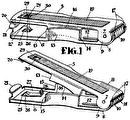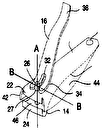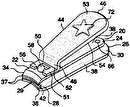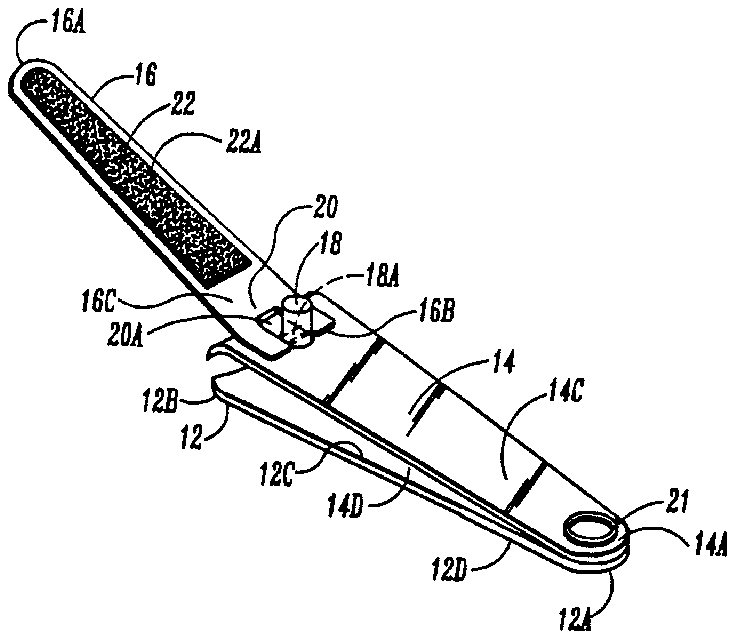
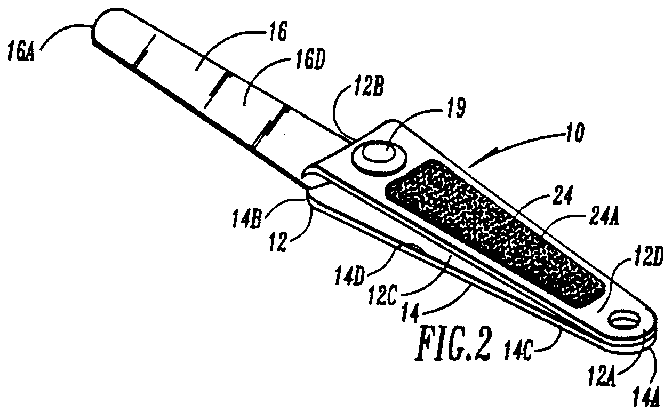
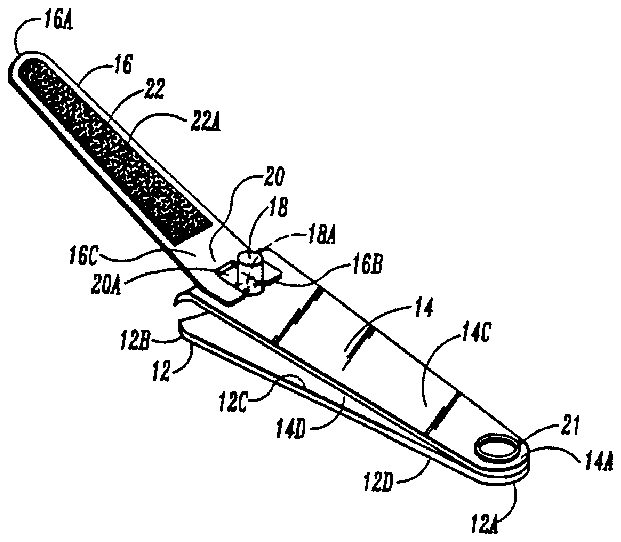
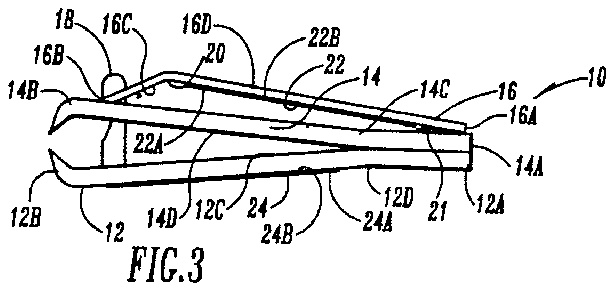
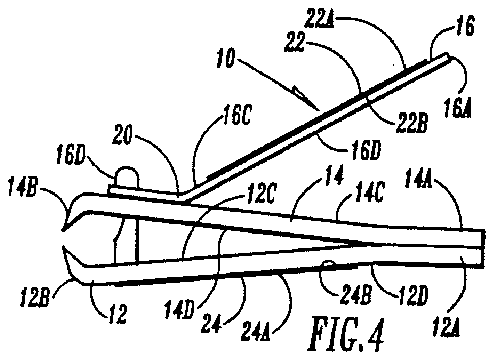
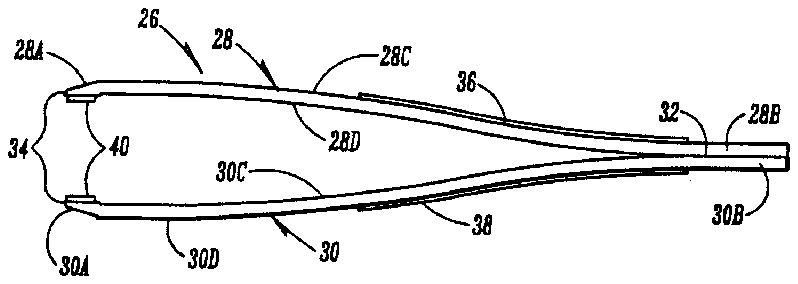

- 10clipper tool
- 14lever element
- 16lever
- 18post
- 19bearing
- 20bent portion
- 21like
- 22strips
- 24strips
- 26tweezer
- 34gripping areas
- 36frictional strips
- 38frictional strips
- 40frictional segments
- 180longitudinal axis
Abstract
A finger-operated leverage tool has first and second lever elements with opposite ends and upper and lower elongated surfaces. A connection joins one end of each of the lever elements and holds the lever elements in a movable angular position with respect to each other. Elongated frictional surface strips of a material different than the material of the lever elements are secured to the upper surface of the first lever element and to the lower surface of the second lever element to prevent slippage of the fingers of a person operating the tool.
Description
BACKGROUND OF THE INVENTION
The finger-operated leverage tools, such as nail clippers or tweezers, always include oppositely disposed lever elements which are secured together at one end and held in a slight angular position with respect to each other. The tools are operated by forcing the two lever elements together to accomplish either a nail clipping or a grasping function.
Such tools are operated by the thumb and forefinger of the person using the tool. The tools are normally chrome plated and have a very smooth and slick exterior surface.
Some of these tools have laterally extending serrations extending across the finger gripping areas to provide the operator with a better grasp of the tool and to permit the fingers from slipping thereon while the tool is being used. However, the plating material applied to the tools often substantially fills the serrations, and very littler frictional force is therefore provided by the serrations. As a result, existing tools are often difficult to graph and operate, and this is particularly true of elderly people.
Therefore, it is a principal object of this invention to provide a finger-operated leverage tool that has a frictional surface secured to the gripping areas thereof to prevent the fingers from slipping on the tool while it is being used.
A further object of this invention is to provide a finger-operated leverage tool that will provide a frictional surface on the finger grasping areas that is much less expensive and more functional than the serrations commonly used on tools of the prior art.
These and other objects will be apparent to those skilled in the art.
SUMMARY OF THE INVENTION
This invention pertains to a finger-operated leverage tool, such as a nail clipper or tweezer, that has first and second lever elements with opposite ends and upper and lower elongated surfaces. A connecting means joins one end of each of the lever elements and holds the lever elements in a movable angular position with respect to each other.
Elongated frictional surface strips of a material different than the material of the lever elements is secured to the upper surface of the first lever element and to the lower surface of the second lever element to prevent slippage of the fingers of a person operating the tool as the fingers engage the strips to operate the tool by forcing the lever elements towards each other.
BRIEF DESCRIPTION OF THE DRAWINGS
FIG. 1 is a perspective view of a nail clipper embodying this invention with the operating lever element in an extended position intermediate its storage position and its operating position;
FIG. 2 is a view similar to that of FIG. 1 wherein the device of FIG. 1 has been rotated about its longitudinal axis 180°;
FIG. 3 is a side elevation of the device of FIG. 1 in its storage position;
FIG. 4 is a side elevation similar to that of FIG. 3 but shows the tool in its operating position;
FIG. 5 is a side elevational view of an alternate form of the invention showing a tweezer structure; and
FIG. 6 is a top plan view of the device of FIG. 5.
DESCRIPTION OF THE PREFERRED EMBODIMENT
A nail clipper tool 10 is shown in FIGS. 1-4 and is comprised generally of a base lever element 12, an intermediate lever element 14, and an operating lever element 16. Lever element 12 has ends 12a and 12b, and upper surface 12c and a lower surface 12d. Lever element 14 has ends 14a and 14b, and upper surface 14c, and a lower surface 14d. Lever element 16 has opposite ends 16a and 16b, an upper surface 16c, and a lower surface 16b.
A post 18 is rotatably secured by its lower end to the upper surface 12c adjacent end 12b by means of bearing 19 (FIG. 2). The post 18 extends upwardly through an aperture (not shown) in lever 16 as shown in FIGS. 1, 3 and 4. Ends 12b and 14b constitute the cutting edges of clipper tool 10.
The end 16b of lever 16 is pivotally secured to the upper end of post 18 by means of a horizontal pin 18a which is shown by the dotted lines in FIG. 1.
A bent portion 20 exists in lever 16 as best shown in FIGS. 3 and 4. The bent portion 20 exists adjacent a center recess 20a in the end of lever 16 (FIG. 1). The lever 16 can be rotated about a vertical axis, i.e., the vertical axis of post 18, and this also causes the post 18 to rotate about its vertical axis by means of the bearing 19. Lever 16 can also be rotated about the horizontal axis of pin 18a as it is moved from the position in FIG. 3 to the positions of FIG. 1 and/or FIG. 4.
The ends 12a and 14a of lever elements 12 and 14 are secured together by a rivet or the like 21.
The structure described thus far defines a conventional nail clipper, and the foregoing structure does not of itself embody the essence of this invention.
Elongated frictional strips 22 and 24 are secured to (FIG. 4) the upper surface 16c of lever 16 and the lower surface 12d of lever 12, respectively. Strips 22 and 24 are comprised of a medium texture polymer with pressure sensitive adhesive and are available through the 3M Co. Strips 22 and 24 have exposed surfaces 22a and 24a and adhesive surfaces 22b and 24b. The exposed surfaces 22a and 24a of frictional strips 22 and 24 has the texture of medium grade sandpaper. It is held to the surfaces of tool 10 by the adhesive surfaces 22b and 24b.
With reference to FIG. 4, the thumb of the person using the clipper 10 normally engages the frictional strip 22, while the forefinger engages the frictional strip 24. As the thumb and fingers exert pressure on the tool to cause the lever 16 to move towards the lever 12, the strips 22 and 24 prevent slippage with respect to the person's thumb and finger on the levers 16 and 12, respectively.
With reference to FIGS. 5 and 6, a tweezer 26 is shown comprised generally of a first lever element 28 and a second lever element 30 which are welded or otherwise secured together at 32. Lever element 28 has ends 28a and 28b with an upper surface 28c and a lower surface 28d. Lever element 30 has opposite ends 30a and 30b with an upper surface 30c and a lower surface 30d. Gripping areas 34 are located on the ends 28a and 30a of levers 28 and 30. Elongated frictional strips 36 and 38, similar to frictional strips 22 and 24, are secured to the respective surfaces 28c and 30d of lever elements 28 and 30 as best shown in FIG. 5. Frictional segments 40 are secured to the gripping areas 34 located on the ends 28a and 30a respectively of the levers 28 and 30.
The frictional strips 36 and 38 serve the same function as the previously described strips 22 and 24. The frictional segments 40 permit the tweezers to better grasp small components when the tweezers are used, for example, in assembly of circuit boards and the like comprised of very small components.
From the foregoing, it is seen that this invention has solved one of the principal drawbacks from existing finger-operated leverage tools by providing a frictional surface on the gripping portions of such tools to prevent the fingers from slipping on the tools while they are being used. It is thus seen that this invention will accomplish at least its stated objectives.
